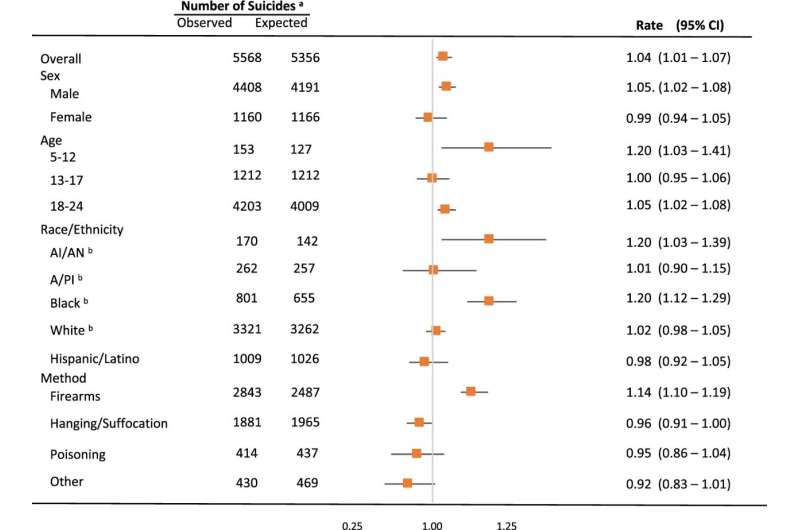Study finds youth suicide rates increased during COVID-19 pandemic, especially among particular subgroups

Suicide is the second leading cause of death for individuals aged 5–24 years in the United States, and a significant public health concern. Data suggest depression, anxiety and social isolation increased during the COVID-19 pandemic, which may have contributed to suicide risk in youth.
In a study published today in Pediatrics, researchers in the Center for Suicide Prevention and Research at Nationwide Children’s Hospital found that in the United States, youth suicides increased during COVID-19, with significantly more suicides than expected among males, non-Hispanic American Indian/Alaskan Native youth, and non-Hispanic Black youth.
“To our knowledge, no national study examined changes in youth suicide rates that occurred during the COVID-19 pandemic,” said Jeffrey A Bridge, Ph.D., lead author of the study and director of the Center for Suicide Prevention and Research at Nationwide Children’s Hospital. “We wanted to a see if there were any changes in the youth suicide rate that occurred and whether these changes happened with the onset of the pandemic.”
National trends in suicides were sourced from the Web-based Wide-Ranging Online Data for Epidemiologic Research (WONDER) database from the Centers for Disease Control and Prevention (CDC). Individuals aged 5–24 years between 2015 and 2020 with suicide listed as the cause of death were included in this analysis. The start of the COVID-19 period was defined as March 2020.
A total of 5,568 youth living in the United States died by suicide during the COVID-19 pandemic in 2020. The majority of youth decedents were male (79.2%), non-Hispanic White (59.6%) and died by firearm (51.1%).
Compared with pre-pandemic suicide deaths, more suicides during the COVID-19 pandemic occurred among males, preteens aged 5–12 years, young adults aged 18–24 years, non-Hispanic American Indian/Alaskan Native youth, and non-Hispanic Black youth. Suicides by firearm were higher than expected during the pandemic, whereas suicide deaths by hanging or suffocation and poisoning were lower than expected.
Suicide rates during the pandemic were also higher than expected among non-Hispanic Asian/Pacific Islander females, non-Hispanic White males aged 5–12 years, non-Hispanic American Indian/Alaskan Native males and non-Hispanic Black males aged 18–24 years.
Most notably, no subgroup had significantly fewer suicides than expected.
“We found an overall increase in the suicide rate, but that wasn’t distributed equally across all subgroups. A couple of findings really stand out, such as the higher-than-expected suicide rate among non-Hispanic Asian or Pacific Islander females, for example. This is a group of young people that typically have a very low rate of suicide relative to other young people, and to see an increase in their rate associated with the COVID-19 pandemic was a cause for concern,” said Donna Ruch, Ph.D., co-author of the study and principal investigator in the Center for Suicide Prevention Research at Nationwide Children’s Hospital.
The findings of this study highlight the importance of suicide preventive interventions tailored to better address racial and ethnic disparities in youth at highest risk for suicide. An increase in suicide by firearms also draws attention to the continuing need to promote safe gun storage practices. Additionally, preteen rates of suicide are increasing, warranting further research and clinical attention for this understudied subpopulation at risk.
More information:
Jeffrey A. Bridge et al, Youth Suicide During the First Year of the COVID-19 Pandemic, Pediatrics (2023). DOI: 10.1542/peds.2022-058375
Journal information:
Pediatrics
Source: Read Full Article
